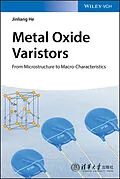Completely up-to-date, this is the first comprehensive monograph on metal oxide varistors with a focus on microstructure, conduction mechanisms, device failures, ageing, additive impacts and future varistor systems.
As such, it covers the fundamentals and applications of metal oxide varistors, including their macro-characteristics, microstructural properties and the device-internal physical and electrical mechanisms. The author reflects on the achievements made in varistor research and propose new approaches to analyze and predict the macro-characteristics, employing such methods as micro-contact measurements and numerical simulations. In addition, he looks at future directions for varistor research, such as ZnO varistors with a high voltage gradient and low residual voltage and further varistor types based on TiO2 and SnO2.
Autorentext
Jinliang He is the Chang Jiang Scholars Distinguished Professor of China's Ministry of Education with the Department of Electrical Engineering of the Tsinghua University, Beijing, China. Currently Jinliang He is the Chair of the High Voltage and Insulation Technology Research Institute at the Tsinghua University. His research interests cover dielectric materials and electroceramics, transient electromagnetics and electromagnetic compatibility in power systems and electronic systems as well as advanced power transmission technology. During 2014 to 2018, he had been assigned by China Science and Technology Ministry as the Chief Scientist in charge of a 5-year China National Fundamental Research Project. He has co-authored more than 310 papers in peer-reviewed international journals and transactions and more than 200 papers in refereed Chinese-language journals. He has published 5 academic monographs, and 2 textbooks. He was elected a Fellow of IEEE in 2007 and a Fellow of IET in 2011 for his contribution to lightning protection and grounding technology in power transmission system , and a Fellow of HPEM in 2018 for contributions to the understanding and protection of lightning discharges and electromagnetic effects. Jinliang He received the "Technical Achievement Award" and "Certificate of Acknowledgement" of the IEEE-EMC Society, respectively in 2010 and 2011, the Hoshino Prize (6th session) by the Institute of Electrical Installation Engineers of Japan in 2013, the Distinguished Contribution Award from Asia-Pacific International Conference on Lightning in 2015, the Rudolf Heinrich Golde Award from International Conference on Lightning Protection in 2016, and 2018 IEEE Herman Halperin Electric Transmission and Distribution Award for contributions to lightning protection of power transmission systems, including advancing analytic methods and innovation in line surge arresters. He is the recipients of two Chinese national awards for scientific and technological progress, a Chinese national invention award, and 20 provincial and ministerial science and technology awards.
Inhalt
Preface xiii
Acknowledgments xv
1 Introduction of Varistor Ceramics 1
1.1 ZnO Varistors 1
1.2 Fabrication of ZnO Varistors 3
1.2.1 Preparation of Raw Materials 4
1.2.2 Sintering of ZnO Varistors 5
1.3 Microstructure 6
1.4 Typical Parameters of ZnO Varistors 7
1.5 History of ZnO Varistors 9
1.6 Applications of ZnO Varistors 12
1.7 Alternative Varistor Ceramics 17
1.8 CeramicPolymer Composite Varistors 18
References 22
2 Conduction Mechanisms of ZnO Varistors 31
2.1 Introduction 31
2.2 Basic Concepts in Solid-State Physics 33
2.2.1 Atomic Energy Level and Energy Band of Crystal 33
2.2.2 Metal, Semiconductor, and Insulator 35
2.2.3 Characteristics of FermiDirac Function 37
2.2.4 Impurity and Defect Energy Level 38
2.3 Energy Band Structure of a ZnO Varistor 39
2.3.1 Energy Band Structure of a ZnO Grain 39
2.3.2 DSB of a ZnO Varistor 40
2.3.3 Microscopic Origin of DSB 41
2.3.4 Asymmetric IV Characteristics of the DSB 43
2.4 Conduction Mechanism of a ZnO Varistor 45
2.4.1 Conduction Model Based on Thermionic Emission Process 46
2.4.2 Minority Carrier Generation Process 49
2.4.3 The Bypass Effect Model 51
2.5 Dielectric Characteristics of a ZnO Varistor 51
2.5.1 Explanation to Dielectric Properties of a ZnO Varistor 52
2.5.2 Effect of Interfacial Charge Relaxation on Conducting Behavior of ZnO Varistors Under Time-Varying Electric Fields 54
2.5.3 Determination of Barrier Height and Related Parameters 58
2.5.4 Determination of Deep Donor Level in the ZnO Varistor 59
2.5.5 Determination of Grain and Grain Boundary Conductivity 60
References 62
3 Tuning Electrical Characteristics of ZnO Varistors 67
3.1 Introduction 67
3.2 Liquid-Phase Fabrication 68
3.2.1 Microstructure of ZnO Varistor 68
3.2.2 Polymorph of Bismuth Oxide 71
3.2.3 Influence of Bi2O3 Concentration 72
3.2.4 Volatilization of Bismuth Oxide 72
3.3 Preparing and Sintering Techniques 74
3.3.1 Fabrication 74
3.3.2 Fabrication Stages 75
3.3.3 Effect of Pores 76
3.4 Role of Oxygen at theGrain Boundary 78
3.5 Dopant Effects 79
3.5.1 Effects of Additives 79
3.5.2 Donor Dopants 82
3.5.3 Acceptor Dopants 86
3.5.4 Amphoteric Dopants 87
3.5.4.1 Monovalent Dopants 88
3.5.4.2 Trivalent Dopants 89
3.5.5 Effects of Rare Earth Oxides 92
3.5.6 Dopants for Improving the Stability 93
3.5.7 Evidence for Hydrogen as a Shallow Donor 95
3.6 Role of Inversion Boundaries 95
3.7 High Voltage Gradient ZnO Varistor 98
3.8 Low Residual Voltage ZnO Varistor 101
3.8.1 Residual Voltage Ratio 101
3.8.2 Low Residual Voltage ZnO Varistors by Doping Al 103
3.8.3 Low Residual Voltage ZnO Varistors by Doping Ga 106
3.8.4 Low Residual Voltage ZnO Varistors with High Voltage Gradient 108
References 110
4 Microstructural Electrical Characteristics of ZnO Varistors 125
4.1 Introduction 125
4.2 Methods to Determine Grain Boundary Parameters 126
4.2.1 The Indirect Method 126
4.2.2 The Direct Microcontact Methods 126
4.3 Statistical Characteristics of Grain Boundary Parameters 129
4.3.1 Nonuniformity of Barrier Voltages 129
4.3.2 Distribution of Barrier Voltage 131
4.3.3 Distribution of Nonlinear Coefficient 132
4.3.4 Distribution of Leakage Current Through Grain Boundary 133
4.3.5 Discussion on Microcontact Measurement 133
4.4 Classification of Grain Boundaries 134
4.5 Other Techniques to Detect Microstructurally Electrical Properties of ZnO Varistors 137
